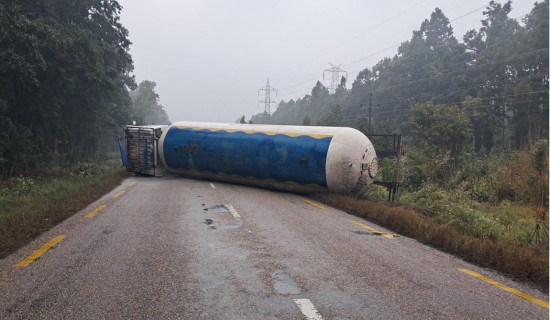- Tuesday, 30 December 2025
Manage Hospital Waste Properly
Healthcare is one of the fundamental rights of people. There are healthcare facilities such as hospitals, nursing homes and laboratories around the world. On the one hand, such healthcare facilities take care of people when they are ill, while on the other they also produce waste, called medical or healthcare waste, while carrying on healthcare-related activities. According to the World Health Organisation (WHO), healthcare waste denotes the waste produced by healthcare establishments, research facilities and pathology laboratories. According to Nepal’s Solid Waste Management Act, 2011, medical waste means the hazardous waste produced and discharged from hospitals, clinics, pharmacies, dispensaries, blood banks, pathology laboratories, veterinary institutions and health research centres.
As per UNEP/SBC/WHO, 2004, healthcare waste includes non-risk healthcare waste, healthcare waste requiring special attention, infectious and highly infectious waste and radioactive waste. Healthcare facilities produce both hazardous and non-hazardous waste. As per the WHO, around 85 per cent of the total waste produced by healthcare installations is non-hazardous, while the remaining 15 per cent is hazardous. Such hazardous waste is infectious, toxic or radioactive. However, in Nepal most healthcare facilities mix hazardous healthcare waste with general waste. Small amounts of hazardous waste are often mixed with large amounts of non-hazardous waste, leading to more hazardous waste.
Open-air burning
Healthcare waste is also burned in the open areas of healthcare facilities. Open-air burning not only pollutes the areas of healthcare facilities but also affects the surrounding areas and the health of the general public. Such pollution may give rise to respiratory diseases and contaminate the environment. Healthcare waste needs to be properly segregated before disposal. When such waste reaches landfill sites along with general waste, it is often collected by scrap collectors. Such scrap collectors may get infected by the hazardous waste. Besides, the areas around the landfill sites and the people living there may also be affected by the infectious waste.
All healthcare facilities should have a proper healthcare waste management system in place. Poor management may result in the contamination of soil and groundwater besides adversely affecting public health and leading to the waste of available resources. Hazardous waste may also affect the quality of water and agriculture land. When agriculture land is affected, food safety may also be compromised. So healthcare facilities should pay heed to the installation of waste management infrastructure such as sophisticated incinerators and autoclaves. Open-air burning destroys recyclable materials, pollutes the air and contributes to climate change. Use of incinerators reduces the quantity of waste, thus facilitating waste disposal.
On the other hand, autoclaves reduce greenhouse gas emissions and are less polluting than incinerators. Healthcare facilities should adopt the ‘reduce, reuse and recycle’ policy of waste management. The waste generated by healthcare facilities should be segregated at source. Reusable waste can be sold and additional cash can be earned. Healthcare facilities should adopt appropriate technology so as to reduce exposure of their waste to protect public health as well as the environment. They should also train their staff in waste management.
Healthcare facilities should follow the standard operating procedure for segregation, collection, transportation, storage, treatment and final disposition. There is the National Healthcare Waste Standard Operating Procedure, 2020 in force. The procedure should be followed by all the healthcare facilities. The Ministry of Health and Population has also formulated regulations regarding appropriate disposal of healthcare waste. In Nepal, healthcare facilities are rapidly coming up. Private healthcare facilities have outnumbered government-owned healthcare establishments. With the growth of healthcare facilities, the waste generated by such facilities has also increased. So it is imperative to manage healthcare waste in a systematic way, failing which patients, healthcare workers and the general public may be exposed to hazardous waste.
Moreover, drug-resistant microbes can also be generated by such waste. The spread of such microorganisms can pose a threat to public health. Antimicrobial resistance, as the phenomenon is called, has become a serious challenge in the health sector. Nepal is a country where many people cannot afford healthcare services. So healthcare facilities should take concrete measures to stop the transmission of infectious diseases through untreated healthcare waste. They should follow the Healthcare Waste Management Guideline, 2014 to ensure that no adverse consequences arise from the management of healthcare waste (handling, storage, treatment and disposal) and to protect public health and the environment.
Guideline
The guideline requires healthcare facilities to set up a proper waste management system. Improper management will contribute to producing more hazardous waste. The guideline sets a minimum standard for the safe and efficient management of healthcare waste. Monitoring and enforcement of the guideline are also equally important. Healthcare facilities should also follow national and international regulations regarding healthcare waste management. What is more, waste handlers, health workers, patients, attendants and the general public should be sensitised to the deleterious effects generated by healthcare waste on public health and the environment.
The early recovery of patients is contingent upon infection prevention practices. Proper management of healthcare waste is one of the essential components of good infection prevention practices. Healthcare facilities should take upon themselves the responsibility for properly disposing the waste generated by them for the sake of promoting community health. Properly managing healthcare waste can contribute to creating a healthier society and a sustainable environment. So it is not only the ethical responsibility but also the legal responsibility on the part of healthcare facilities to dispose of the waste generated by them in a proper way. After all, healthcare facilities should consider proper healthcare waste management one of their prime responsibilities.
(Maharjan has been regularly writing on contemporary issues for this daily since 2000.)
















